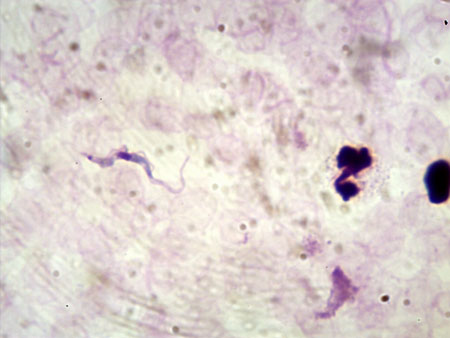Summary
Definition
History and exam
Key diagnostic factors
- previous stay in rural west and central Africa (Trypanosoma brucei gambiense)
- previous stay in game parks in east and southern Africa (T b rhodesiense)
- enlarged cervical lymph nodes/Winterbottom sign (T b gambiense)
- chancre (T b rhodesiense)
- disturbances of consciousness and sleep
Other diagnostic factors
- history of several treatments against malaria with no improvement
- headache
- fever
- fatigue and general malaise
- history of infertility, menstrual disorders, high miscarriage rate (women)
- reduced libido, impotence (men)
- pruritus
- edema
- impaired motor functions
- mental changes
- signs of cardiac failure (T b rhodesiense)
- rash
- hepatosplenomegaly
- sensory disorders
Risk factors
- exposure to tsetse fly
- living or working in an area with people infected with gambiense trypanosomiasis
- living or working in an area with animals infected with rhodesiense trypanosomiasis
Diagnostic tests
1st tests to order
- complete blood count
- erythrocyte sedimentation rate
- serum immunoglobulins (Ig)
- rapid diagnostic tests
- card agglutination test for trypanosomiasis (CATT)
- immunofluorescence
- enzyme-linked immunosorbent assay (ELISA)
- chancre aspirate microscopy
- lymph node aspirate microscopy
- blood microscopy
- microhematocrit centrifugation technique
- quantitative buffy coat technique
- mini-anion exchange centrifugation technique (mAECT)
Tests to consider
- electrocardiogram
- cerebrospinal fluid (CSF) white blood cell (WBC) count
- CSF microscopy
- double centrifugation of CSF
- modified single centrifugation of CSF
- CSF protein
Emerging tests
- polymerase chain reaction (PCR)
- reverse transcriptase real-time PCR (RT-PCR)
- intrathecal immunoglobulin production
- stage biomarkers
- immune trypanolysis
- T b gambiense inhibition ELISA (g-iELISA)
- MRI brain
Treatment algorithm
gambiense human African trypanosomiasis (HAT)
rhodesiense human African trypanosomiasis (HAT)
relapse
Contributors
Authors
Veerle Lejon, PhD
Director of Research
Institut de Recherche pour le Développement
Montpellier
France
Disclosures
VL is an author of several references cited in this topic. VL declares that she has no competing interests.
José Ramón Franco, MD, MPH
Medical Officer
Control of Neglected Tropical Diseases
Human African Trypanosomiasis Control Program
World Health Organization
Geneva
Switzerland
Disclosures
JRF is an author of several references cited in this topic. JRF declares that he has no competing interests.
Pere P. Simarro, MD, PhD
Former head of WHO HAT control and surveillance programme
WHO temporary advisor
World Health Organization
Geneva
Switzerland
Disclosures
PPS is an author of several references cited in this topic.
Peer reviewers
Sanjeev Krishna, MA (Cantab), BMChB (Oxon), DPhil, FRCP, ScD (Cantab), FMedSci
Professor of Molecular Parasitology and Medicine
Centre for Infection
Division of Cellular and Molecular Medicine
St. George's
University of London
London
UK
Disclosures
SK is a consultant for the Foundation for Innovative Diagnostics, a non-profit organization developing diagnostics for neglected diseases such as HAT. SK is an author of a reference cited in this topic.
Mike Barrett, BSc, PhD
Professor
Division of Infection and Immunity
Institute of Biomedical and Life Sciences
The Glasgow Biomedical Research Centre
University of Glasgow
Glasgow
UK
Disclosures
MB declares that he has no competing interests.
Peer reviewer acknowledgements
BMJ Best Practice topics are updated on a rolling basis in line with developments in evidence and guidance. The peer reviewers listed here have reviewed the content at least once during the history of the topic.
Disclosures
Peer reviewer affiliations and disclosures pertain to the time of the review.
References
Key articles
World Health Organization. Guidelines for the treatment of human African trypanosomiasis. Jun 2024 [internet publication].Full text
Centers for Disease Control and Prevention. Clinical care of human African trypanosomiasis. Apr 2024 [internet publication].Full text
Reference articles
A full list of sources referenced in this topic is available to users with access to all of BMJ Best Practice.

Differentials
- Malaria
- Typhoid fever
- Relapsing fever
More DifferentialsGuidelines
- Guidelines for the treatment of human African trypanosomiasis
- Clinical care of human African trypanosomiasis
More GuidelinesLog in or subscribe to access all of BMJ Best Practice
Use of this content is subject to our disclaimer